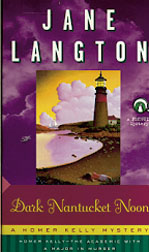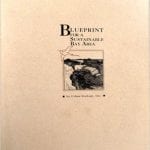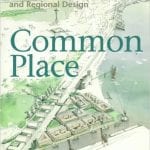By Karen Kristiansson
As a city planner, I hear of a lot of books that sound like well-written and insightful works on important urban issues, some reviewed on these very pages. I have found that no matter how hard I try, however, I cannot manage to read all of them. And all too often, I prefer to sit down with a light, entertaining book at the end of a long work day rather than one that will demand my concentration.
For those of you who share the same problem, let me offer some help: mystery books that feature urban or environmental issues. If you doubt a good mystery can be written on these topics, just think of the passions aroused by planning issues. From proposing a major new development or disposing of toxic waste to simply rebuilding a wall on a property line, urban and environmental problems offer all of the ingredients of a good mystery.
My all-time, hands-down favorite mystery of this type is God in Concord by Jane Langton. One of the main storylines in the book concerns the proposed siting of a mixed-used development near Walden Pond in Concord, Massachusetts, and the resulting clash between the developer, various environmentalists, and Thoreau enthusiasts. Town politics and finance, the tailoring of the development proposal to address some local concerns, and the interplay of local personalities are all described in Langton’s inimitable and irreverent style. Langton does not oversimplify the issues either. On the one hand, the development, Walden Green, would generate much-needed revenue for the town, would include affordable housing, and would provide essential infrastructure such as a sewer extension. On the other, Walden Green would be located a scant half mile from Walden Pond, home of Henry David Thoreau and symbol of the importance of nature.
As the story unfolds, a number of subplots come into play. There is Mimi Pink’s quest to gentrify Concord’s town center by replacing, for example, the dime store with the Den of Teddies. There are the actions of Sarah Peel, a homeless woman from Boston who discovers Concord and relocates there, bringing nine other homeless people with her. And there is the disposal of Lot Seventeen, a mystery of its own until the end. Langton weaves these stories together, illustrating various connections among these urban issues as she does so.
Some may find the intricate interrelationships of these plots to be unrealistic, since things rarely work out that neatly in real life. Most mystery books feature an element of un-realism, however, in that the bad guy is caught and brought to justice at the end. The fact that Langton manages to weave all of the strands of the story together to produce a single whole makes for a satisfying story and is one of the book’s charms. Along the way, Langton manages to illustrate the balancing that often goes into making development decisions: the need for affordable housing and the need for revenue against the need to preserve historic and natural places, for example. She also shines a light at the working of town politics, including humorous (although, sadly, somewhat accurate) descriptions of the budgeting process and public meetings.
For those of us tired after a day of work, the real advantage is that these items are simply presented as part of the plot. There are no lengthy descriptions or lectures, no statements that we’re all doing it wrong, no easy answers. Rather than discussing the issue of homelessness in the abstract, for example, Langton includes a number of homeless people as characters. The book includes these characters’ thoughts as well as others’ thoughts about homelessness, as well as some potential approaches to the problem, but does not attempt to present global solutions.
In addition to the intricate plot and the inclusion of key urban and environmental issues, the other reason to read God in Concord is the characterization. The cast of characters includes a wild-eyed naturalist, a dull, respectable chairman of the Planning Board and his nice wife, a young and naïve Indian idealist, a determined boutique owner, a horse-loving homeless woman, a pragmatic developer, and the residents of the only trailer park in town, among others. Through it all galumphs Langton’s protagonist, Homer Kelly, a clumsy and eccentric scholar of transcendentalism and a former policeman. While some of the characters are more completely and realistically drawn than others, the interactions between them form some of the most interesting parts of the story.
Homer is featured in a number of other mysteries by Langton, including at least two others with plots or subplots that revolve around environmental and development issues. Dark Nantucket Noon features the Nantucket Protection Society and a bylaw to prevent development on a large portion of the island. Characters in this book include realtors, property owners, nature lovers, and old Nantucket families, all forming the backdrop for the investigation into a murder of which an off-island poet is accused. Once again, the development debate is not presented simplistically. Along with the few rich speculators, for example, those against the bylaw also include individuals who want to build a single house or who were depending on money from the land for needs such as college costs or retirement.
Natural Enemy includes issues such as moving property lines, historic preservation, state politics, and transportation planning interspersed with information on natural history. An interesting twist in this book is the way in which nature acts as a witness and source of information. Spiders, yellow jackets, apple trees, and winter wheat are all “characters” of a sort in this book. As in Langton’s other mysteries, there is also a varied and interesting cast of human characters, although I found a few here to be less fully developed and less believable.
Each of these books provides an interesting tale and some food for thought on urban and environmental issues. While they do not provide the type of comprehensive overview of or information on these issues that a nonfiction book would, they do provide something that may be equally important-a view into the human side of these issues and the ways in which they interconnect. So next time you’re thinking that you should really read a lengthy but very informative book on a worthy urban topic but you’re feeling like a casual read, try one of Langton’s books as a compromise.
Karen Kristiansson is a Senior Planner with Spangle Associates, an urban planning and research firm in Portola Valley, California.
More Mysterious Reading
Another mystery that deals with the issue of gentrification is Grandmother’s House by Janet LaPierre, about a development proposal on California’s north coast. Mysteries that focus on environmental themes, although not always urban ones, include: Where Echoes Live by Marcia Muller, on mining and water issues in the eastern Sierra Nevada mountains; Blind Descent by Nevada Barr, which also concerns mining but this time near Carlsbad Caverns National Park; or Zodiac by Neil Stephenson, a very different type of story on PCB dumping in Boston Harbor. Rudolfo Anaya bridges genres — mostly mystery and magical realism — in his novels about Albuquerque. Zia Summer, Rio Grande Fall, and especially Alburquerque — the spelling is old Spanish — wrap appealing stories of intrigue around themes of development, environmental abuse, and cultural clash in the urban Southwest.
Books Mentioned Here
God in Concord, by Jane Langton, Penguin Books, 1992, $5.99.
Dark Nantucket Noon, by Jane Langton, Penguin Books, 1975, $5.99.
Natural Enemy, by Jane Langton, Penguin Books, 1991, out of print.
Grandmother’s House, by Janet LaPierre, Harlequin Retail, 1991, $6.34.
Where Echoes Live, by Marcia Muller, Warner Books, 1995, $6.99.
Blind Descent, by Nevada Barr, Avon, 1999, $6.99.
Zodiac, by Neal Stephenson, Bantam Spectra, 1995, $6.99.
Zia Summer, by Rudolfo Anaya, Warner Books, 1996, $6.99.
Rio Grande Fall, by Rudolfo Anaya, Warner Books, 1996, $6.99.
Alburquerque, by Rudolfo Anaya, Warner Books, 1994, $6.99.







